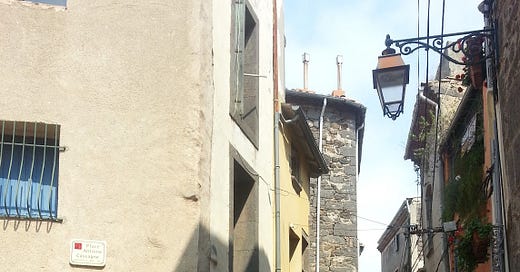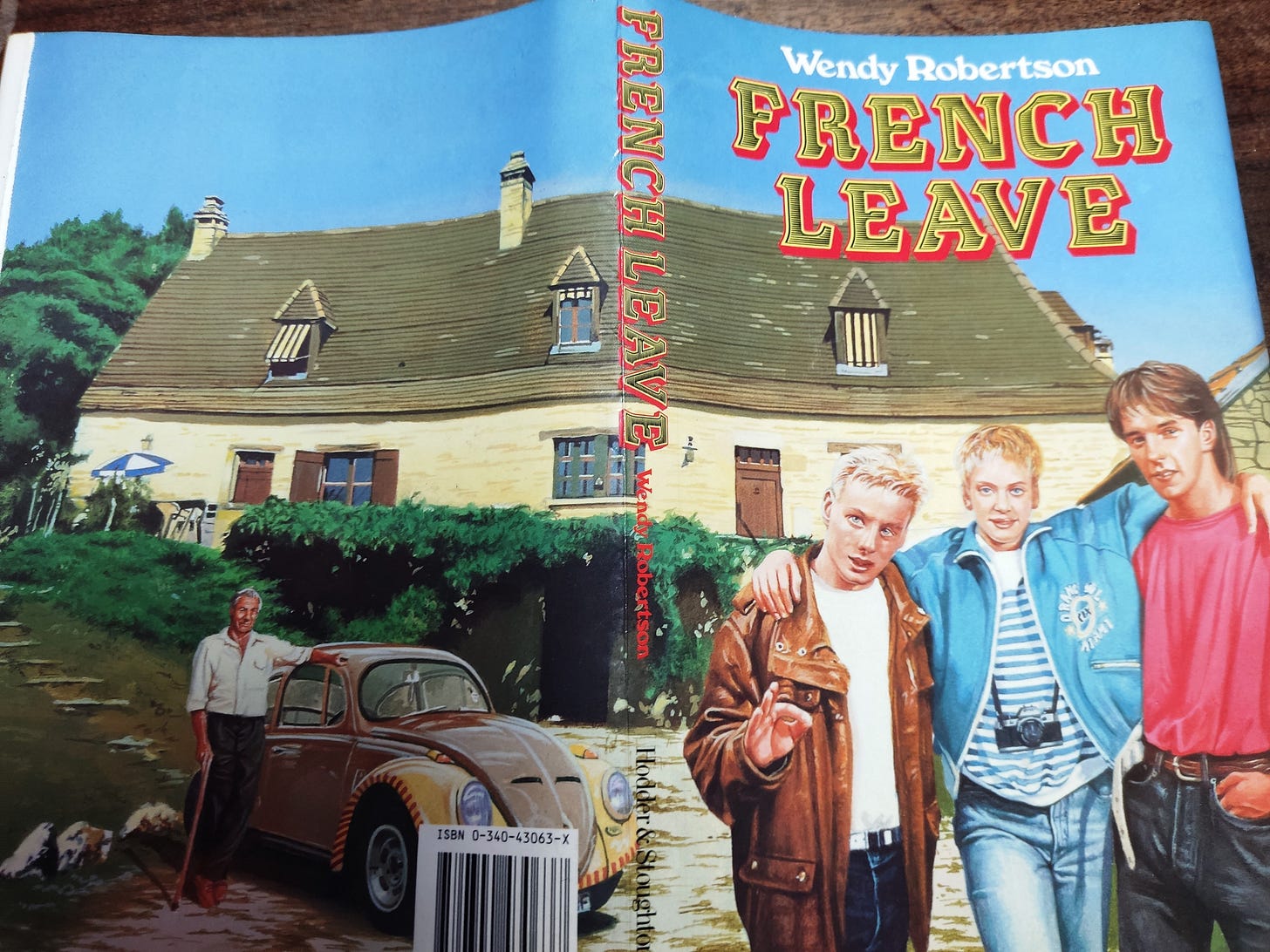A passion for France: Two novels
Staying in the Langaudoc & the stories behind my novels "French Leave" and "An Englishwoman in France"
“Writers live life twice. Once in living it and again in writing it.” Anais Nin
Author’s note on ‘Living Life Twice’: Writing a novel is such an intense, personal experience the I certainly live my life twice through each novel. This means that l have ‘lived life twice’ twenty or so distinct times.
I am halfway through a two-month stay in Marseillan in the Languedoc, orchestrated by my daughter Debora to haul me out of the despair and depression brought about by a heartbreaking bereavement, followed by a debilitating bout of Covid. It has been a highly personal process of recovery fostered by my passion for France.
I studied French from the ages of eleven to eighteen under the gifted tutelage of Mr Phorson. From the day I entered his classroom to the day I left we never spoke English in class. ‘Open the windows! Sit up straight! Stop chattering!’ were all negotiated in French. We soon caught on.
When I was about thirteen, each day Mr Phorson gave us eight new French words to memorise which were tested the next day. At seventeen and eighteen I was reading the short stories of Guy de Maupassant, the novels of Émile Zola and Honoré de Balzac, and the poetry of Arthur Rimbaud and Paul Verlaine. Being from a poor background I never got to visit France in those years. But I did get to imagine it. So no wonder that in all my life since then I have been in love with France and all things French - history, fashions, films, songs and singers - you name it!
As a more affluent adult I have visited France many times for short periods but now I am staying here for two months with my daughter and her husband, who live and work here in an historic house in a charming Langedocean village by the Mediterranean. So since those early years it is also no wonder that France and French life have crept into my novels at one time or another. For your interest here the most significant novels are; French Leave (1988), An Englishwoman in France (2011), and Writing at the Maison Bleue (2015).
By the time my third young adult novel was published in 1988 my son and daughter were in their early twenties. It could be that their childhood was a very long study in the identity and worldview of both boys and girls.
So in writing French Leave I found it a pleasure to explore the relationship between two boys, Joe and his Romany friend Skemmer, as well as Joe’s relationship with his grandfather who, determined to share his World War Two memories with his grandson, inspired the adventure. Never having known either of my grandfathers – or only having met them in my imagination – it was also great fun that as well as exploring the relationship between Joe and Skemmer I enjoyed inventing the relationship between Joe and his grandfather.
1. French Leave (Hodder Children's Books, 2011)
First, in this newsletter I pay tribute to the influence of France on my fourth novel French Leave.
When I wrote French Leave I had only actually been to France once when my husband Bryan and I drove off the channel ferry in our blue Jaguar* with our friends Bob and Lil. It was a deep pleasure for me at last to hear French as she is spoken and, as we explored the small towns of Normandy, to observe the norms and practices of everyday life . There were so many non-text book lessons to learn there – not least the one about the primacy of food.
Since then I have enjoyed visits to many parts of France right down to the Languedoc in in the far South West which, like my own North East of England, as its own take on language which refuses to be tamed by the formal demands of the national language.
So the first novel to feature my passion for France is French Leave, telling the story of a boy and his war veteran Grandfather.
*This Jaguar subsequently inspired the poem below.
‘17 year old Joe shares a close friendship with his grandfather Bob. The grandfather suggests a trip to France, the scene of his wartime experiences. They travel in Bob’s old banger, gaily painted by Joe’s Romany mate Skemmer who accompanies them. The confident and enterprising Skemmer is an odd companion for Joe, whose shyness and lack of direction is something of a stumbling block for this, his first visit to the continent and his encounter with a friendly outgoing American girl. A little rivalry, memories of a tragic past and a present-day crisis also help Joe to learn more about himself, to establish his first relationship with a girl and come to terms with an uneasy family situation.’
Blue Jaguar
Her ears crackle and she holds her breath
as churches, houses, halls and corner shops
canter by at such a pace.
She sees her own end mirrored
in a smaller window –
one pane even shows a mangled death.
In a larger window, figures crowd
in quiet corridors – people talking,
some even lifting their heads in laughter.
At last she sees the stony steeple –
her true birthright – telling her
she was here once and will be again.
Now, a comic strip unreeling -
the land flows past bright reaching corn
as the Jaguar purrs by, eating up the miles.
Her body, not understanding, opens up
in involuntary exhilaration.
You can find this poem in my 2021 collection “With such Caution” (Damselfly books).
2. An Englishwoman In France (Severn House Publishers Ltd 2011 & Damselfly books 2018)
In this second part of the Newsletter I explore the great influence of the Languedoc on my novel An Englishwoman In France - a story about grief and recovery.
Like her mother and grandmother Estella (called Starr) is gifted with second sight. She can see though time and glimpse the future. Starrr earns a very modern living with a syndicated astrology column, where she shares her gift with her readers. When her daughter Siri dies in violent circumstances she falls into grief-ridden depression.
Alternating with Starr’s grief-ridden story is the Roman-era story on the same French territory, of Tib the son of Helée, the Roman Governer of Good Fortune, now called Saint-Thibéry, a village near Agde where Starr goes to stay with her friend Mae and her family. The narrative moves between present-day Agde and Roman-time Agde as the stories of Starr and Tib unfold side by side.
Starr’s second sight is instrumental for grasping and accessing the story of Tib and his charismatic mentor Modeste - known as The Corinthian. We meet another character when, in the present day, Starr bumps into Madame Patrice and her dog Misou. Madame Patrice, who, like Starr, also experiences both time frames.
It might be of interest here that I myself had to re-read the 2011 novel thoroughly again to tackle this Newsletter.
As I read it again by my Marseillan window I can see on each page everyday life here coming to life – the narrow streets of higgledy-piggledy houses bleached by the sun, the gaggle of ships’ masts on the port and between the two rows, the sun gleaming on the water. And I feel a deep sense of history as I walk through the avenue of trees alongside the Canal du Midi as it makes its way towards the Étang and the Mediterranean Sea.
In the story Starr continues to struggle with her grief. So many times I can hear her as she cries out to herself ‘Oh Siri!’
Today, twenty odd years later I feel her grief join with my own. And as Starr’s grief begins to fade, so does mine.
And I still learn things here as I write. When I wrote this novel I named my heroine’s daughter after the wife of W Somerset Maugham, Siri. Now here, because my fellow guest is Swedish, I discover that Siri is a Swedish name. I go on to discover that in Swedish the name means Victory: Beauty. My fellow-guest also tells me that in the modern world it is also the name for Apple’s virtual assistant. It seems I was ahead of the time - if only by a few months!
NEXT TIME
My next newsletter will talk about my other novel which focuses on France: WRITING AT THE MAISON BLEUE. This focuses on the different stories of a group of writers who gather together to share their stories and find their inspiration here in the Languedoc, as I do.







